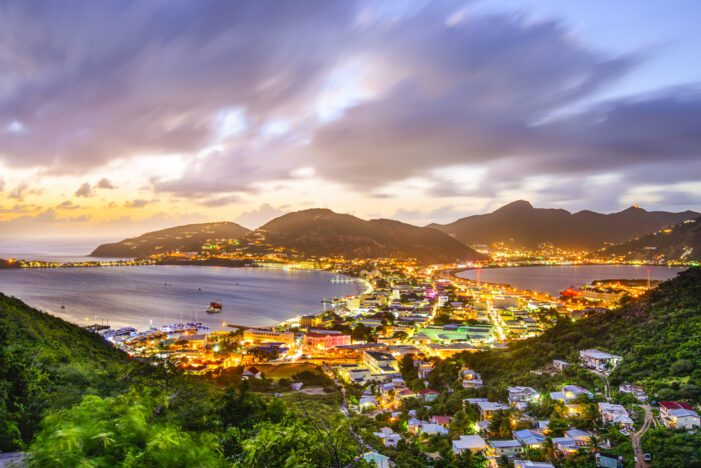Saint Martin / Sint Maarten is a unique Caribbean island divided between two European powers: the French Collectivity of Saint Martin in the north, and the Dutch Sint Maarten in the south. This duality creates a richly multicultural and multilingual environment, ripe for culturally aligned investment, economic opportunity, and diaspora relevance. For African American investors, the island offers a blend of Afro-Caribbean heritage, U.S. access, European stability, and favorable investment frameworks.
- Culture & Heritage
Saint Martin’s population is predominantly of Black or mixed Creole ancestry, with influences from Africa, France, the Netherlands, India, Latin America, and Asia. Cultural life thrives on both sides of the island:
- On the French side, music blends gwo ka, zouk, soca, and calypso, while Carnival, art, and literary festivals mark strong Creole identity.
- The Dutch side hosts the annual Grand Carnival, regattas, music festivals, and a book fair featuring Caribbean writers.
Cuisine merges Creole, French, West Indian, and Latin flavors. The island is celebrated as the “Gourmet Capital of the Caribbean” on the French side, while the Dutch side is known for vibrant nightlife, casinos, and beach cocktails like guavaberry.
These traditions reflect deep Afro-Caribbean roots and provide fertile ground for heritage-driven initiatives, especially festivals, professional partnerships, culinary pop-ups, and artist residencies.
- Language & Accessibility
- French Saint Martin uses French officially and is fully integrated into the EU.
- Sint Maarten recognizes Dutch, English, and English-based creoles in daily life.
- Papiamentu, Spanish, and Haitian Creole are also spoken across communities.
For African American investors, this multilingual environment offers access in English while allowing cultural ventures to tap French and Creole heritage authenticity.
- Economic Profile & Key Sectors
Tourism dominates both jurisdictions—comprising over 80% of GDP on Sint Maarten and employing nearly 85% of the local workforce. Antoine Princess Juliana International Airport and luxury marinas support yacht tourism and cruise traffic.
Other sectors include:
- Financial services and offshore structures supported by favorable Dutch frameworks.
- Retail and gastronomy, especially on the French side, with duty-free shopping and culinary tourism.
Much economic activity is consumer and service-based, with light industry and food imports making up the remainder.
- Investment Incentives & Residency
Dutch Sint Maarten
- Residency by investment: Foreigners (except U.S. citizens under a special friendship treaty) can qualify via US $500,000 (ANG 900,000) real estate or business investment.
- Tax regime: No property or capital gains tax, low transactional costs (~6% transfer tax), and access to Dutch legal entities and trust structures for asset protection.
- Business incentives: Payroll rebates (6% on new jobs for up to 10 years) and capital expenditure tax credits support job-creating enterprises.
French Saint Martin
- Tax incentives: Eligible real estate may benefit from Girardin industrial/housing deductions and a 30% income tax credit for principal residences (Article 199 undecies D).
- Business-friendly frameworks: Philharmonic ease of doing business, EU funding for sustainable projects, and cultural program support recognized at the national level.
- Opportunities for African American Investors
Creative & Cultural Tourism Ventures
Develop boutique hotels, island residencies, Afro‑Caribbean music or arts festivals, pop-up culinary experiences in marinas or Marigot. Anchoring projects in Carnival, musical heritage, and Creole storytelling can attract diaspora engagement.
Luxury Real Estate Investments
Buy beachfront villas or condos in Orient Bay (French side) or Point Blanche (Dutch side) for rental income and residency eligibility. Properties are in global demand and benefit from duty-free status, tax exemptions, and EU legal protection.
Growth Business & SMEs
Start export-oriented retail, gastronomy, yacht services, or halal hospitality aligned with local culture. Small businesses offering guided cultural tours, artisan crafts, or media content can qualify for employment rebate incentives.
Asset Structuring & Legal Residency
Use Dutch Sint Maarten holding vehicles (B.V., foundations, SAS) to manage assets with European treaty benefits and minimal disclosure. U.S. nationals may leverage the Dutch-American Friendship Treaty for residency without family investment.
- Strategic Approach for African American Investors
- Define your objective — prioritize between cultural legacy, residency, income generation, or asset protection.
- Choose side of the island — French offers EU credibility and subsidized incentives; Dutch provides simpler entry, tax advantages, and stronger flexibility.
- Partner locally — engage with Saint Martin tourism boards, cultural associations, and local developers to build authentic projects.
- Embed Afro-Caribbean identity — integrate Creole music, cuisine, storytelling, and art into branding for diaspora resonance.
- Leverage incentive frameworks — align real estate or business plans with payroll rebates, Girardin tax schemes, or SME grants.
- Work with experts — use authorized investment and legal advisors to navigate dual jurisdictions, property laws, and tax planning.
- Prioritize sustainability and ESG — cultural preservation, climate-resilient developments, and community engagement strengthen legitimacy and access to public support.
- Outlook & Summary
Saint Martin stands out as a dual-jurisdiction Caribbean island offering a rare intersection of Afro-Caribbean culture, European governance, and economic flexibility. Tourism fuels most of its economy, yet investment pathways remain open—from luxury real estate to cultural ventures to business anchor investments.
For African American investors, the island offers choices: the French side connects to EU perks and funding, while the Dutch side delivers faster residency, zero taxes, and Dutch legal structures. Projects that honor Afro‑Caribbean heritage—through festivals, cuisine, music, and storytelling—can deliver both financial value and diaspora impact.
As a unique territory bridging cultures and economies, Saint Martin offers investors a place where heritage, mobility, and entrepreneurship meet in a culturally rich, legally robust Caribbean setting.


